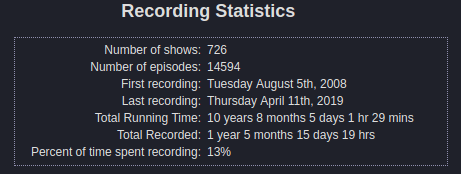There is no single piece of entertainment software used by my family more than MythTV over the past decade. It has been a great ride. Now that I’ve cut the cord, it’s time to say goodbye. Here is my journey from the beginning to the end.

Table of Contents
What led me to MythTV
Rewind to 2006.
I’ve always been a fan of Linux, and I’ve always wanted to provide a rich multimedia experience in my home. I had compiled a large amount of digital music, videos, and pictures I wanted to be organized. I wanted all of this content to be easily streamed to computers throughout our home.
Additionally, I was not at all happy with the DVR supplied by the cable company. It was slow, had limited storage, and extremely cumbersome to use. I had played with SageTV, MediaPortal, and even Windows Media Center. Although there were good things about all of them, none of them quite did what I wanted and were open source and ran on Linux.
Then I found MythTV. It had all the features I was looking for and more. Some of the highlights for me:
- Powerful DVR – Extremely granular control of recording rules and as much storage space as I could buy.
- Comprehensive multimedia management – It manages pictures, music, videos, and recordings and supports playback of all the formats I could think of.
- MythTV can automatically detect and skip commercials – At the time, this was like a magical feature to me.
- A web interface – I could view and schedule recordings easily from a web browser.
- Ability to export recordings – I could take my recordings with me if I wanted to.
- Good hardware support – I was able to use both analog and digital recording cards.
- Distributed architecture – You can have multiple backends recording and looking up metadata and commercial flagging and all coordinating with each other.
I also really appreciated the MythTV community. Many people were active in support and development.
My initial install
I settled on the Ubuntu platform, and luckily there were up to date packages I could install. Configuration was fairly involved. I walked through quite a few configuration screens telling MythTV about my recording devices, storage locations, database passwords, etc.
For each frontend, I tweaked how MythTV displayed on the screen and how it transmitted audio. I installed drivers and firmware for some tuner cards and graphics cards. At the time I think it was important to know a lot about your hardware to get a good experience.
Eventually, I got it all to work and it was glorious. Cable companies transmitted the majority of their content digitally unencrypted via QAM. My digital tuner cards were able to record everything I wanted.
Music, recordings, videos, and pictures were available on every computer and TV in the house. I absolutely loved the ability to skip commercials!
Expansion
Over time, MythTV supported more and more hardware and became easier and easier to install. Mythbuntu came of age and made install and configuration much more accessible to many people. Unfortunately, cable companies tried to make it harder and harder to record content without their DVRs.
They started encrypting their QAM signals and stopped transmitting analog signals. I responded by learning how to control and record from their cable boxes using a firewire connection. I also bought a cheap indoor antenna and began to record local stations over the air.
Hardware appropriate for MythTV became better and less expensive. I started off with one, somewhat loud, desktop connected to my TV. Eventually, I standardized on using Atom powered Zotac bookshelf computers that were quiet, low powered, and provided flawless video to each of my TVs. Cheap IR receivers connected to each frontend allowed me to control MythTV with my universal remote.
My final stable MythTV configuration
Eventually, the cable companies closed the loophole on most digital and all analog recording. I had to use a cable card and a Silicondust HD Homerun Prime to record to MythTV, and due to copy protection flags MythTV would only be able to record some of the channels I subscribed to.
I eventually switched to Direct TV, although I still received the basic cable channels via the cable card as part of my Internet package. There is no cable card with DirecTV, but their boxes had analog component outputs. This allowed me to use an HD-PVR to record in high def to MythTV.
My final configuration consisted of:
- Zotac bookshelf computers connected to each TV, each controllable with a universal remote (I preferred Logitech Harmony models).
- HD Homerun Prime for recording locals from cable, and an HD-PVR to record premium stations from DirecTV.
- Two backend (custom built) computers that store photos, videos, and recordings.
I ran with this configuration for years. Occasionally I upgraded the computers or MythTV, but mostly just let it run. Everything pretty much worked flawlessly. I had a fault tolerant multimedia distribution system running in my home.
The beginning of the end: cutting the cord
Over time, the DirecTV subscription became too expensive. Their DVRs started failing and I had a series of horrible customer service experiences. Thus began my journey to cut the cord.
As I moved from DirecTV to YouTube TV, I no longer needed MythTV as a DVR or for live TV. I standardized on the Roku streaming platform and I wanted all of my streaming video (including local media) to be accessed via a Roku app. This would provide my family with a unified experience, and reduce my support load!
So, I replaced the MythTV DVR functionality with YouTube TV, and I replaced the photo and video streaming with Emby. I no longer needed MythTV.
After cutting the cord, I shut down and repurposed or sold all of my MythTV only hardware. I started using MythTV in 2006 but did a full rebuild and fresh start in 2008. Below is how much my family used MythTV over the years.

After 15000 recordings, and 13 years, it’s the end of an era.
Final thoughts
There are still many reasons to use MythTV. There are now stable Android apps, and installation and configuration have never been easier. It just doesn’t work best for my use case anymore.
I’m gonna miss it. It was light years ahead of other systems and installs had become easy. 6 months into cutting the cord, I don’t think I’m going back. My technology and viewing needs have changed, and my technology stack must change with it.
Interested in supporting HomeTechHacker?
Have you found the content on this site useful? If so, are you interested in supporting me and this site? There’s no obligation of course, but I would really appreciate any support you can give. Below are a few ways you can show support:
- Share this site with your friends and on social media (use the sharing links at the end of this page for your convenience)
- Subscribe to this site
- Purchase one of my books, The Personal Cybersecurity Manual, The Home Network Manual or The Smart Home Manual, for yourself or as a gift
- Put a link to HomeTechHacker on a site you have access to. Be sure to let me know about it!
- Enroll in HomeTechHacker Academy for free and premium online home technology courses.
- Reach out to me via my contact page or Twitter and let me know something I should write about
- Shop at Amazon through my affiliate links and ads on these pages. See my disclosures for more details about affiliate links. You can also just shop from one of the links below:
- HomeTechHacker Shop: This is a listing of products that I use, have reviewed, and that I recommend
- HomeTechHacker Technology Advisor: This suite of tools will give you customized home technology product recommendations based on your needs
- My Amazon affiliate link: Just click on this link to go to Amazon and shop
Thank you! I really appreciate it!
This page contains affiliate links. If you purchase an item using an affiliate link I will receive a small commission at no cost to you. Affiliates do not influence my recommendations. Read my disclosures for more information.


